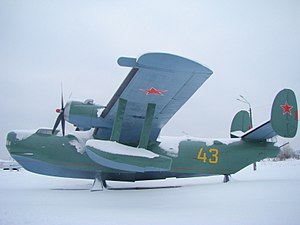Beriev Be-6
| Be-6 | |
|---|---|
 |
|
| Be-6 at Ukrainian State Aviation Museum | |
| Role | Maritime reconnaissance and patrol aircraft |
| Manufacturer | Beriev OKB |
| First flight | 1949 |
| Retired | Late 1960s |
| Primary users |
Soviet Navy People's Liberation Army Naval Air Force |
| Produced | 1949–57 |
| Number built | 123 |
| Developed into | Beriev Be-12 |
The Beriev Be-6 (USAF/DoD reporting name "Type 34",NATO reporting name "Madge") was a flying boat produced by the Soviet Beriev OKB. It was capable of accomplishing a wide variety of missions, such as long-range maritime reconnaissance, coastal and supply line patrols, torpedo/bombing strikes, mine-laying, and transport operations.
The Be-6 was a gull-winged aircraft with twin oval vertical stabilizers on top of a deep fuselage. The aircraft was of all-metal construction except for fabric covering the rudders and ailerons. The fuselage was divided into eight watertight compartments to improve survivability. The engines were installed in the bends of the wings with the floats on an underwing cantilever rack. Each float was divided into four watertight compartments.
The Be-6 was built from 1949 to 1957 at the Beriev plant in Taganrog. The aircraft went through 19 variants through its production cycle, and 123 aircraft were eventually built. Since requirements of Soviet naval aircraft did not change rapidly, the reliable Be-6 stayed in service until the late 1960s. Some aircraft ended service as civilian unarmed transports in Arctic regions. One survivor is preserved at the Ukraine State Aviation Museum in Kyiv, Ukraine. Beriev Be-6s operated by the Peoples Republic of China PLANAF proved useful in patrolling the long coastline and huge territorial waters off China's coast. During the 1970s the original Shvetsov radial engines began to wear out with no replacements available, so several aircraft were re-engined with Wopen WJ-6 turboprop engines, in new nacelles, for a new lease of life and were redesignated Qing-6.
...
Wikipedia
